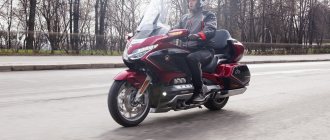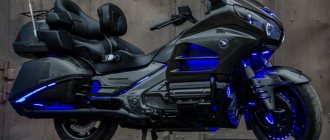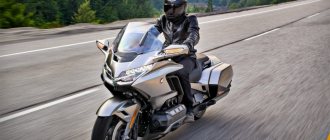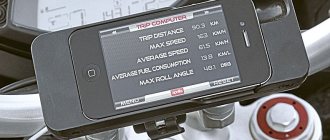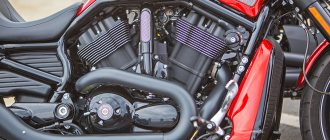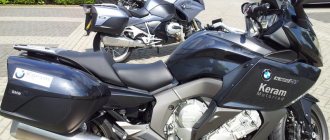Symptoms of engine repair on a BMW K 1200 LT are:
- Extraneous noise in the engine
- High oil consumption
- Coolant flow
- Low compression in the engine or large difference between cylinders
- Excessively high compression associated with carbon deposits in the combustion chamber
- Blue smoke from the muffler
- Obvious oil leak from the engine
- Transmission problems
- Disassembly of BMW K 1200 LT for engine removal
- Removing the BMW K 1200 LT engine
- Cleaning the engine before disassembly
- Disassembling the motor
- Complete engine troubleshooting
- Cleaning the engine from metal shavings and other contaminants
- Diagnosis of all engine bearings and gears
- Replacement of worn/broken/bent parts
- Engine assembly
- Checking valve clearances
- Engine installation on BMW K 1200 LT
- Final assembly of the BMW K 1200 LT, launch
- All engine repair work is carried out by a highly qualified mechanic with extensive experience. A 1 year guarantee is provided for all work performed.
Stages of work on repairing the BMW K 1200 LT engine:
Valve adjustment BMW K 1200 LT
Check the thermal clearances of the valves according to the service manual for your BMW K 1200 LT, as well as after disassembling the head or replacing the timing chain or when a characteristic “clunking noise” appears from the cylinder head.
Increased valve clearances lead to increased noise when the engine is running, and if the clearances are too small, the valves will not close, and the engine will not develop rated power, and sometimes it will be difficult to start.
Our service center provides:
Please note that after adjusting the valves, in some cases it is necessary to synchronize the carburetors.
Test drive BMWK 1200 LT, HondaGL 1800 Gold Wing
The starting point for the emergence of modern luxury tourer motorcycles was 1975. It was then that the first Honda Gold Wing was born. It was a motorcycle with classic lines, the steel frame of which was wrapped around a liquid-cooled four-cylinder boxer engine. However, at that time the public demonstrated their vision of such technology - some smart people even managed to take part in the first “golden wing” in the race.
In 1980, Honda deeply modernized the model, introducing a motorcycle equipped with an impressively sized fairing with integrated panniers. Now even those who like to put an asphalt paving roller under their knees had no doubt about the purpose of the new Gold Wing. Honda's unconditional hegemony in the luxury tourer class was trampled only in 1999, when the first BMW K 1200 LT appeared. German engineers developed their motorcycle according to the same principles that guided the creators of the “Golden Wing”, but they did it at a new, much higher technological level. After this, Honda engineers were tasked with completely reworking the model, creating a motorcycle with a more modern, rigid chassis and better handling. And they succeeded, although not immediately - for 3 years, from 2001 to 2003, the new “Golda” suffered from a serious manufacturing defect - during intensive tourist use (this did not affect pure “show-off drivers”) its frame burst! Then this gap was “closed” by strengthening the weak points. In response to this, the Germans greatly modernized the K 1200 LT in 2004, slightly improving its appearance, expanding the dashboard with a display and an on-board computer, and also increasing engine power and the efficiency of the braking system. But they struck the main blow “below the belt” precisely at the “luxury” prefix - for the first time in the world, an electro-hydraulic jack was installed on a heavy motorcycle, capable of placing it on the center stand along with the driver, passenger and luggage! Agree that it is not a “royal thing” to install a heavy tourer on the center console manually. It's not glamorous. It's a matter of pressing a button. And last year, the K 1200 LT completely passed the “second-hand” clan - it was discontinued. Many who would like to buy a “top of top-class” have the opportunity to do so for significantly less money. Now it’s clear why the question: “Who is the best?” placed on a completely different plane. We also wanted to place two heavyweights in different corners of the “ring”... In accordance with the concept of “to each his own,” Honda was “packed” to the maximum, and BMW has the most functional tuning.
BMW K 1200 LT
Since I was familiar with the “golden-winged” specimen long before the test, I decided to start with the BMW. The first thing that catches your eye is the Bavarian’s incredibly developed plastic hoods, which can rival the size of the outfits of Russian pop divas. I couldn’t dare call it a fairing.
Despite the fact that the K 1200 LT is huge, like a whale and pathetic, like Philip Kirkorov, it does not give the impression of an uncontrollable glamorous lump.
In pursuit of “luxury”, the manufacturers of both motorcycles went beyond all limits of reason, turning the bikes into a kind of Cadillac motorcycle. Take BMW, for example. Slipping almost into the car seat, you see two burdock-shaped rear-view mirrors (they have excellent visibility, but they have a habit of jumping off their mounts when driving quickly through deep holes), a dashboard with a large display and a considerable number of buttons, as well as a huge windshield fly swatter with electrical adjustment.
Once started, the four-cylinder 1171 cc engine with horizontally arranged cylinders operates like a car power unit - quietly and without unnecessary vibrations. However, with the latter, not everything is clear. At idle, noticeable vibrations are transmitted to the seat and steering wheel, which completely disappear as soon as you open the throttle slightly. But, rather, this is a property of this specimen rather than a characteristic feature of all K 1200 LT. I, accustomed to more laconic motorcycles, was initially tormented by concerns about riding through capital traffic on a kind of two-wheeled barge. While I was standing in the parking lot, listening to the engine warming up and looking at the buttons, thoughts about the criteria for evaluating such a motorcycle came into my head.
I hoped that the prospective owner of the BMW K 1200 LT would have little interest in information about handling, extreme lean angles, wheelie and the behavior of the front suspension during stop-and-go braking. The ideology of “luxury tourers” is rather based on the concepts of prestige, comfort and safety. Therefore, it seems that it is necessary to evaluate this technique precisely according to these criteria. But, as it turned out, it’s not that simple. So, back to the moment of getting into the driver’s seat... Inquiring about the level of comfort on a luxury tourer motorcycle is bad manners. The seating position on it is either absolutely comfortable, or it is not a “luxury tourer” - there can be no other option. The seat politely accommodates the pilot’s “fifth point,” and the steering wheel grips are located exactly at the height where you intend to feel them.
Since the engine was already running and warmed up, I squeezed the moderately tight clutch, put it in first gear and rode the lacquered behemoth towards the exit of the parking lot. Thanks to the impressive torque available from the bottom, you can start almost from idle. The linear nature of the engine’s operation from the very first meters resembled an electric motor. However, the feeling of riding an extremely fast “trolleybus” did not leave me until the end of the test.
At low speeds, the K 1200 LT's impressive curb weight of around 380 kilograms is felt. By the way, it also reminds you of itself when leaving the parking lot, when you need to roll the hefty motorcycle back. Fortunately, the engineers foresaw this possibility and built into this BMW a reverse system driven by... an electric starter. But in order to reach the corresponding switch, you need to reach into the area of the gear shift foot with your hand. After opening the throttles, the “extra” kilograms dissolve in space after starting off. Incredibly, this clumsy-looking fat man surprisingly easily shifts from side to side even before reaching a speed of 20 km/h! The horizontal injection “four” with 116 “horses” quite briskly accelerates the bike to 140-150 km/h, after which the acceleration decreases slightly. This is followed by a period of up to 180 km/h, in which the K 1200 LT still actively responds to turns of the throttle. Further acceleration occurs smoothly and sedately, but this “piano on wheels” reaches the allotted two-plus hundred without much effort. If you lower the windshield (with electrical height adjustment, by the way) all the way and fit as compactly as possible behind the fairing, then the traffic police radar will show the final 215 km/h. However, BMW does not like such modes. At high speeds, small nasty vibrations begin to spread throughout the motorcycle, “blurring” the image in the mirrors, and all the engine’s forces are wasted in vain fighting air resistance. Fuel consumption at the same time... you understand.
However, even at such speeds the wind protection is quite decent. A wide fairing coupled with a high windshield (plus mirrors and additional shields) protects the rider from wind and rain from head to toe. True, if the wind deflector is raised to the very top, then the driver has to look at the road through a thick layer of transparent polycarbonate. As long as the surface of the latter is clean, no problems arise, but settled dust, dirt and smeared midges greatly impair visibility. It's a pity that the motorcycle is not equipped with an electric wiper... However, what am I talking about - you can start to miss the roof and an extra pair of wheels! I hit the brakes. That's it, but it's very difficult to argue with BMW in this discipline. Honda. There is a feeling that a brake parachute is opening behind the motorcycle. Just in case, I even looked for it in the mirrors, but I couldn’t verify its presence or absence.
What's the secret? The K 1200 LT has an electric brake booster, traditional for tourers of the Bavarian brand, which harmoniously complements the integral ABS. Thanks to this, you can bring down a heavy vehicle from speeds of “under 200” either with one finger or with the whole hand, without any fear of “over-braking.”
Thanks to the Telelever front suspension, there is ABSOLUTELY no dive when braking, which is typical for conventional telescopic forks. The motorcycle just “squats” and that’s it! Since we are talking about suspensions, we cannot help but mention the K 1200 LT’s attitude to the unevenness of our “directions”. This example had a Wilbers front shock absorber, so it very gently “filtered out” any defects in the road surface, creating a subjective feeling of a good road. But if a pilot, corrupted by comfort, flies at a good speed onto a section of chipped and wavy asphalt, then he is guaranteed a memorable “shake.” Although this is not a problem - it’s enough to stand up on the pegs (by the way, this is extremely easy to do - almost like on an enduro). Or you can generally stand up to your full height and ride like this for quite a long time - the high handlebars, wide footpegs and the ability to fix straight knees make this position quite functional and comfortable. Golda does not provide such an opportunity.
As we went deeper into the city, the traffic became denser. It was no longer possible to drive pretentiously along my lane without changing course, so I began to draw the usual “snake” between the cars. Only after about the third dozen of “canned” rides did I remember that I was driving not a sportbike, but an almost five-star hotel on wheels. The K 1200 LT, surprisingly, responds well to the steering wheel and is able to squeeze into row spaces the same width as a regular road bike with panniers. With some skill, an experienced rider on this BMW will not lag behind a lighter bike. However, everything has its limits. Only when the average speed of the flow dropped to 2.5 km/h, and the motorists buried themselves in each other’s tails, leaving space in the aisle only for a narrow motard, did I appreciate the real size of the motorcycle.
Although the width of the K 1200 LT is still considerable, its “anti-traffic” capabilities are at a quite acceptable level – in most cases it is possible to “leak” between cars before a traffic light. But, even if it is impossible to squeeze further, the K 1200 LT, to its credit, provides the rider with an excellent opportunity to pretend that “this is how it should be.” Standing in a traffic jam, the “Bavarian” literally imbues the pilot with condescending contempt for the cars around him: “Do you think I’m stuck in a traffic jam? No, you’re the one who’s stuck, and I’m just admiring the sunset and coming into harmony with myself!”
The suddenly available time can be spent usefully. For example, in order to understand how the standard audio system works. As was correctly noted by foreign colleagues, the sound quality and ease of control of a “mafon” for the owner of such a motorcycle sometimes exceed in importance the braking dynamics and handling. All buttons are placed logically, and their purpose is intuitive. However, I was unable to objectively evaluate the sound - my AGV S4 helmet dampens extraneous sounds too well. At this point, it finally dawned on me why a significant number of luxury tourer owners wear caps. Throughout the test, I tried to find words that could describe the checkpoint. The box copes well with its functions and is not prone to crashes or glitches, but its performance cannot be called ideal. The switching foot reaches the stop without the characteristic “clack”. At first I couldn’t understand: had there been a gear change? Fortunately, the dashboard, in addition to the traditional set of indicators, also displays the number of the gear engaged. Moreover, it regularly changed depending on whether there was a “click” or not.
There is one more thing on this BMW (except for electrically adjustable glass), the presence of which cannot be boasted by its competitor in the form of the Honda Gold Wing. We are talking about a hydraulic central stand. Prudent Germans foresaw that the K 1200 LT would be ridden not only by 2-meter “elks” (which I don’t consider myself to be), but also by very compact people (which I also don’t consider myself to be). It is for the latter that this device is included in the basic package. When you press the appropriate button, the BMW independently climbs onto the center stand. At the same time, he will not be embarrassed even by trunks filled to capacity with a total volume of about 100 liters and a passenger who has fallen asleep in the back seat, and believe me, this is impressive.
Honda GLX 1800 Gold Wing
If I compared the K 1200 LT to a five-star hotel on wheels, then the Gold Wing is a six-star hotel. Even doubts arise: is this a motorcycle? Maybe the “Japanese” did not appear at all as a result of the evolution of the motorcycle? What if this is a Cadillac, which for some unknown reason has lost one pair of wheels? However, the facts indicate the opposite.
After talking a little with avid “gold drinkers” from the capital’s crowd, I understood the main postulate on which the cult of the “Golden Wing” is based, namely: “Riding a stock Gold Wing is a complete scam.” That is why, usually immediately after purchase, motorcycles of this model are often overgrown with useful and not so bells and whistles: various chrome plates and lighting that would be the envy of the most luxurious Christmas tree. As a result, the cost of the motorcycle increases, and the Gold Wing itself becomes something like a Vertu mobile phone or a Chairman watch. That is, an expensive, fashionable, but not particularly practical device.
The copy provided to us for testing turned out to be one of these. The number of all kinds of “tinkles” was approaching the limit of reason, making the bike look like a UFO shining with metal and sparkling with lights. In addition, this year’s motorcycle already comes with several interesting devices installed as standard. One of them is a 150-liter airbag, which is located in a false tank. The pyropator is located nearby on the frame, and four accelerometer sensors are mounted on the front fork. Thanks to this, 0.06 seconds after impact, the inflated airbag is ready to receive the pilot. However, you shouldn’t delude yourself, since the manufacturer guarantees driver safety only in the event of a head-on collision at a speed of no more than 50 km/h, and it seems doubtful to me that the pilot of this “cruiser” will drive even at twice that speed!
The most vivid impressions for a person who first became acquainted with “Golda” remain after getting into the saddle. Although no, this process should not be called so mundanely. For example: “diving into a gentle leather ocean.” If we put colorful metaphors aside, we can say that the seat height of the Gold Wing is noticeably lower than that of the K 1200 LT. In addition, the “Golda” sofa is much wider and softer. And what kind of throne is intended for the passenger... Sitting on it is luxurious, but driving is not so great. Due to the low seating position of the driver and the high seating position of the passenger, the latter are noticeably buffeted by the headwind. What about the driver? After landing, straight ahead you see a dashboard, not inferior in the wealth of displayed indicators to the boards of small aircraft. A glance around catches remote controls and panels on plastic replete with buttons. We'll deal with them later.
In the meantime, let's start. The six-cylinder, but at the same time only twelve-valve boxer engine, quite car-sized, starts easily, filling the space around it with a quiet soft hum. Vibrations? What are you about? There are none on Gold Wing. The ergonomics of the driver’s seat are such that I had a desire to “give up” on the test and take a nap for a couple of hours right here. But work is work.
I gently shift into first gear and move off sedately. How else? Haste and impulsiveness in the Golda saddle can be regarded as bad form. From the very first metres, the engine demonstrates its superiority over the power unit of the K 1200 LT. It has amazing torque, which reaches 90 percent level already at 1500 rpm. However, the Gold Wing is superior to the “Teutonic” in terms of weight and size. The only mystery that remains is how Japanese engineers managed to achieve quite tolerable handling from such a “carcass”.
A motor of such a displacement is reluctant to follow the throttle, but it doesn’t need this - it’s not a sportbike. Humming quietly, but without any pathos or special effects, it accelerates a heavy bike to 220 km/h. The gearbox, unlike a similar mechanism on BMW, does not cause any complaints. The box operates quietly, accurately and without unnecessary effort on the part of the driver - as a real Honda should.
Another nice thing is that while driving, the rear-view mirrors provide an absolutely clear image that does not “blur” due to the absence of vibrations.
The comfort of the driver of the Golda is greatly influenced by the windshield. Even before the test, I had the opportunity to ride a Gold Wing of varying degrees of sophistication, therefore, I can authoritatively say that the stock “wind deflector” is the first thing that should be replaced. As standard, this piece of clear acrylic is made to be adjustable in height, but what kind of adjustment is it? In order to raise the glass 4 cm higher, the driver of the GL 1800 needs to wake up, reach with his hands to the front of the cockpit, unlatch the clamps, manually (!) raise or lower the glass, and then fix it again with the clamps. Such a huge list of undignified actions for the sake of 4 centimeters is a serious disadvantage. Considering the cost of the motorcycle, it seems to me that electric windshield adjustment SHOULD have been included as a standard feature.
Now, actually, about the “windbreaker” itself and about comfort. The upper edge is at such a height that the turbulent flow breaking off from it hits the driver’s helmet, due to which noise and head chatter are ensured even at a speed of 100 km/h. Completely different sensations arise when driving with a high (tuning) windshield. In this case, the oncoming air flow completely surrounds the pilot. If the latter becomes hot, then you can open a special deflector, which will direct a refreshing breeze directly into his steamed face. However, Gold also has a remedy for the cold. In addition to the standard heated seats and steering wheel grips (which are also available on BMWs), a flow of warm air can be directed from the deflectors in the area of the pilot’s knees to the freezing lower extremities, and through two valves in the rear of the engine, warm air will warm the feet. What a service!
The Honda Gold Wind suspension initially gives the impression of being even softer and more comfortable than on the Bavarian. But! Everything has its price: if on BMW the suspension travel is 130 mm, then on Honda this value is 140 mm (front) and 105 mm (rear). Thus, the stern often “breaks through” on potholes in our “directions”. Most often, it was this moment that led to cracks in the jumpers of the rear part of the frame.
The Golda's braking system is not bad, but it is inferior to that of the Bavarian. When you press all the levers, three three-piston calipers engage, grabbing two 296 mm discs at the front and one 316 mm at the rear. At the same time, the standard ABS, which is very important for motorcycles of this class, does not allow the wheels to lock. But in order to slow down on the GL1800 as effectively as on the K1200LT, you have to press much harder on the levers - this is due to the absence of an electric booster in the system. And the braking distance of the “Golda” will be longer (due to the greater curb weight, plus the weight of numerous “bells and whistles”).
As the traffic thickens, Gold Wing can register a “snake”, like a real large-capacity neoclassic. Apparently, it was not without reason that this device was dubbed the “flying sofa.” However, this is not a city motorcycle, as its longitudinal and transverse dimensions clearly hint at. If you see a dense traffic jam ahead, then deign to stand at the tail of some “canned food”, put on an impenetrable expression on your face and pretend that “this is how it should be.” Motorists keeping you company in a traffic jam perceive the appearance of the GL1800 as a global event, immediately grabbing their cameras and pointing their fingers at you.
Having nothing else to do, I began to look at the numerous buttons, switches and “twists” scattered in clusters in the front part of the cockpit. Empirically, I easily determined that the radio and CD player are controlled with one finger, and the volume control, track selection and mute buttons are on the left of the steering wheel and are backlit. So at night you won’t have to poke at them at random.
Having finally pulled into a thoroughly packed parking lot, I began squeezing between cars in search of a free space. Yeah... Finding a parking space for Golds is a much more difficult task than for lighter and more compact bikes. But turning with an asterisk is much easier thanks to the presence of reverse gear, the control of which is located on the remote control on the steering wheel.
Opinion: Valery Chuikov (height 186 cm, weight 125 kg)
I have long wanted to “use” a BMW, since I have several friends who drive them for more than one season (and one of them for 6 seasons!). They were attracted by stories not only about the ease of use while traveling, but also about the high driving performance of this luxury tourer (excellent handling in any weather, plus incredible brakes), which allow you to cover thousands of kilometers safely and comfortably. Also, in addition to the high level of active safety, a positive aspect of the passive one was the fact that the Gold Wing 1800, when falling, receives damage to the plastic body kit on both sides - I personally observed such specimens more than once, and BMW practically does not suffer from falls due to powerful crash pads with replaceable plastic linings . There are, however, a couple of nuances regarding operation: firstly, it is advisable to change the rear brake disc mounts from rivet to threaded ones (on models produced before 2006, after a mileage of 12-15 thousand, it can creak at low speeds), secondly, immediately after purchase, you should change the front (at least) stock non-adjustable shock absorber to a tuning adjustable one (several companies make them, but I installed Wilbers). If you do the same operation with the rear shock absorber, you will not recognize your motorcycle. The stock ones are not regulated, are designed for good roads and under a decent load on our clumsy “directions” they often break through. But after replacing them, this heavy tourer is already controlled from a speed of 10 km/h, almost like a good sports tourer, and the suspensions do not require intervention for a long time (more than 60 thousand km), right up to replacing the steering damper or the front arm with a ball joint.
But even the failure of the latter does not affect the driving performance, indicating itself only by a knock. But “Goldovods” should be extremely careful and regularly (in our conditions - once every 10 thousand km) inspect and maintain the fork, in which its only (yes, yes, not everyone knows about this!) working blade quickly and severely wears out, changing the guide bushings and oil seals with anthers. If this is not done, then a motorcycle with a worn fork becomes simply dangerous when riding in the rain - it can turn 180 degrees. Alternatively, the stock fork can also be replaced with a tuning one, but with two working stays and improved performance characteristics, but its cost is steep. The second purchase should be tuning glass with an aerodynamic profile, since for tall people the standard almost flat glass creates a zone of turbulence, making movement uncomfortable for them already from a speed of 90-100 km/h. As for the rest - the seating position, the behavior of the motorcycle on our roads and the mechanics, the situation is as follows: it’s more comfortable for me to sit (and especially stand) on a BMW; I didn’t notice any significant differences in the suspension, except that when passing speed bumps the BMW feels much more confident and can pass them at greater speed. But almost all the thrust of the Golda engine is immediately available, you just need to unscrew the handle, while the ElTeshnik engine requires spinning up to 2500-3000 rpm, and at 5500 you feel a good pickup. But, probably, it was precisely because of the smooth flow of thrust throughout the entire rev range that the Gold Wing in motion, compared to the K 1200 LT, seemed more boring to me, or something. Moving around the city in dense traffic is not a pleasure on any of the motorcycles, but still, due to its slightly smaller dimensions and better stability at “pedestrian” speeds, it is easier to squeeze through to the stop line on a BMW, and not only physically, but also psychologically – on it the width dimensions are more clearly felt, which, moreover, in case of emergency, can be significantly reduced by quickly unfastening the mirrors, but... this is already extreme for the “desperate”. Otherwise, I would characterize these motorcycles as ultra-comfortable tourists, with the only difference being that the BMW K 1200 LT is more suitable for those who prefer higher functionality when traveling to external “show-off”. The Honda GL 1800 is usually chosen by those who take the opposite position and for them the appearance and overall “coolness” of their tourer are more important than its other qualities, including driving characteristics.
Opinion: Denis Shvydchenko (height 175 cm, weight 82 kg)
I bought a motorcycle the season before last because I had wanted to have it in my garage for a very long time. I ordered it from America in the coolest configuration and with tuning. Before that, I rode a sports tourer, but somehow, as I got older, the super speeds stopped attracting me. But all the businessmen I know have either already bought Golda or want to buy it - after all, it’s a status thing! What attracts me personally about this model, first of all, is its appearance, which has no analogues yet! I love it when everyone around me cranes their necks to look at this embodiment of luxury driving down the street. I also like the extreme comfort with which you can travel on it, and not alone, but with a passenger and things. When you start the engine, it immediately becomes clear what level of technology you are dealing with - no vibrations, no unnecessary noise! Plus, there is a huge number of bells and whistles - from a stereo system and cruise control, to a navigator and even an airbag. It's just a pity that the glass is not adjustable. Although, with my height, it just fits me. I haven’t traveled far yet - a couple of times to Crimea and a few meetings. I would like to go to Europe, I think it might happen next year. So far there have been no problems with my luxury tourer, but its mileage is short - less than 15 thousand kilometers. I've only serviced it three times so far - changed the engine oil, filters, and once rebuilt the fork. They offered to put tuning internals in it - like it would be better at absorbing on bad asphalt, and it would also steer, but I don’t see the point of spending money yet; I’m already happy with everything about my “Gold” in terms of its driving capabilities. And then we'll see...
Epilogue
I am gradually becoming an opponent of long-winded afterwords, so the conclusions will be brief. As noted by foreign journalists, in the matter of prestige, the scales tip towards BMW - nevertheless, owning a “German” is more prestigious than “Japanese”. Controversial question! Maybe this is the case in patriotic Germany or other European countries. In Ukraine, in terms of luxury and comfort, Golda unconditionally wins. There is, however, one interesting observation: when buying a K 1200 LT, our travelers begin to travel far and do it for a long time without changing the motorcycle, and those who switch to the Gold Wing, for some reason, prefer to travel on it for a short time, and more often they even prefer to only move around the city, trips to meetings and, as a maximum, rides within the Crimea and back. Paradox or pattern?
Text: Sergey Kuznetsov and Valery Chuikov
Photo: Andrey Shlenchak
Motorcycles provided
private owners
BMW K 1200 LT clutch repair and replacement
One of the most important mechanisms in the BMW K 1200 LT is the clutch. Although this is a fairly simple structural element, it has an important task. The operation of the clutch is based on the frictional force between its discs. The torque of the motor is transmitted to the driven parts, which in turn transmit the torque of the gearbox.
The need for clutch repair in Moscow is dictated by various factors, among which are intensive operating conditions. In addition, repair of the BMW K 1200 LT clutch is required in case of planned wear of its individual elements.
Common BMW K 1200 LT clutch faults
Clutch repair or maintenance involves the following work:
BMW K 1200: technical specifications, model range, pros and cons
The BMW K 1200 RS is a fast motorcycle, and this must be taken into account when calculating fuel consumption. At cruising speed (120 km/h), it consumes about 5.5 l/100 km. But if the speed is 90 km/h, then the consumption is slightly less (4.7 l).
Naturally, if you prefer to drive fast, fuel consumption can reach up to 12 l/100 km (at maximum speed). The quality of the road surface, tailwind or headwind, tire pressure and a number of other factors are also important when taking into account consumption.
Comparison of BMW K 1200 with competitors and analogues
Is it possible to compare something that is unique and considered the best with analogues? Hardly! And this is exactly the case with the BMW K 1200 s. For a long time it was the best of its kind and was considered the most powerful, and therefore no other bike could compete with this bike.
The situation changed when the new Suzuki B-King model was released. Although the latter outperformed its predecessor in terms of technical parameters, it could hardly compare with the BMW 1300 and BMW K1300s. There is a model that is slightly inferior in technical characteristics - the Suzuki Bandit 1200.
It would also be unfair not to draw a parallel with the purely touring BMW 1200 lt. If we take into account the possibility of long-distance travel, this model is still considered more suitable. Take, for example, the length of the base and the presence of a windshield, which increases driver comfort. But the BMW K1200lt still lagged behind in terms of speed. And in terms of weight, the lt 1200 was almost 100 kg more (in the basic configuration).
The motorcycle is presented not only in the database.
There are also modifications, the main ones being:
- BMW K 1200 S (sports)
- BMW K1200R (basic version).
The sports version has a fairing at the front, which improves its aerodynamic properties. In addition, its engine is designed specifically for high-speed driving. Considering that motorcycles in this series were produced from 2005 to 2008, they perform very quickly on the track.
Among the advantages of the BMW K 1200 are:
- tank capacity, for example, if you move at speeds up to 100 km/h, then the tank will be enough for 380 km - a significant indicator,
- high maximum driving speed - up to 262 km/h,
- increased level of security,
- firmly mounted engine and much more.
But it also has its drawbacks. For example, even the sports version, equipped with a front fairing and windshield, is not able to protect the driver from wind currents at high speed. It turns out that after 180 km/h it becomes necessary to lie almost completely on the tank to avoid air resistance.
Roman, 53 years old: “I bought my first bike back in 2004. It was a basic BMW K 1200. I was attracted not so much by the brand as by its appearance, long wheelbase and heavy weight. I went out onto the highway, and then things started to go, as they say... I’ll note right away for everyone that the device is pretty fast! True, after 150, I’ll tell you frankly, his appetite is not that of a child. But I didn’t take precise measurements, since I alternated modes (on a bad road it was somehow scary to drive more than 130).”
Igor, 27 years old: “I took the K 1200 in 2015 (at that time it had covered more than a hundred thousand km). I took the bu option, since finances weren’t particularly good... But I’ll tell you straight - the Germans know their stuff, and their vaunted accuracy is not an empty phrase. Everything works like clockwork! Timely change of consumables is what I can say as a recommendation. Otherwise, the bike is super, I’m happy with the purchase.”
The BMW K 1200 does not need repairs very often. But, of course, from time to time such a need still arises. Spare parts are expensive, but if you buy them not from dubious online resources or service stations, but from official dealers, then repairs will ultimately cost less.
Tuning a motorcycle is a rather controversial issue, since in its pure form it is already focused on meeting all the needs for its operation. Otherwise, drivers often advise using mirrors from the F-800 series, citing practicality and aesthetic appearance.
The history of the BMW K 1200 is quite short...
And although the bike managed to take first place among its competitors, in 2008 it was replaced by the 1300 series. A brief excursion into history:
- 2005 – the first basic version of the bike rolled off the assembly line, went on sale and quickly gained popularity among motorcycle enthusiasts;
- 2007 - S (sport) version appeared. This modification was distinguished by the presence of a traction control system. There were also minor changes in design (the S had a fairing).
- 2008 is the final point of production of the 1200. It was in this year that the 1300 version, a faster and more technically advanced model, was released, and the need for the 1200 disappeared.
By the way, even now many people buy 1200, despite the fact that it has not been produced for 10 years. But this bike can still be found at auctions and secondhand.
Technical characteristics of the BMW K 1200 vary depending on the year of manufacture and modification. Let's look at the general parameters of the motorcycle:
- Let's start with the type of motorcycle - road, also known as "Naked".
- Lightweight aluminum frame.
- In-line 4-cylinder engine with a volume of 1,157 liters.
- Liquid cooling system.
- Economical, as the fuel supply is injection type.
- Power – 163 horsepower.
- The gearbox is 6-speed, and the drive type is cardan.
- The total weight of the basic motorcycle is almost 240 kg.
- Accelerates from 0 to 100 km per hour in less than 3 seconds.
- The maximum driving speed is 262 km/h.
Diagnostics and replacement of timing chain, repair of timing chain tensioner BMW K 1200 LT
Quite often, a malfunction of the BMW K 1200 LT timing chain is caused by an increase in the pitch between the links. As a result, the engine begins to idle incorrectly. Therefore, it is not at all surprising that the chain begins to jump several teeth at the same time. What does this mean? Firstly, the engine will stall. Secondly, the valves may be jammed. This, in turn, may require expensive engine repairs. Therefore, when the first signs of malfunction are detected, it is recommended to replace the timing chain on the BMW K 1200 LT.
